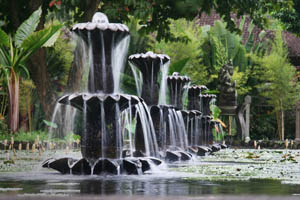 Tirta Gangga is a royal water palace/water garden of Karangasem Kingdom that is still preserved until now, besides Taman Ujung water palace. This tourism object is located in Ababi Village, Abang District, about 83 km from Denpasar or 6 km from Amlapura (the capital city of Karangasem). Tirta Gangga is surrounded by rice fields and lush green hills. Moreover, the sound of water and beautiful view of its garden are a perfect combination for spending a peaceful excursion.
Tirta Gangga is a royal water palace/water garden of Karangasem Kingdom that is still preserved until now, besides Taman Ujung water palace. This tourism object is located in Ababi Village, Abang District, about 83 km from Denpasar or 6 km from Amlapura (the capital city of Karangasem). Tirta Gangga is surrounded by rice fields and lush green hills. Moreover, the sound of water and beautiful view of its garden are a perfect combination for spending a peaceful excursion.
Tirta Gangga was first built in 1948 by Anak Agung Anglurah Ketut Karangasem, the king of Karangasem at that time. Just like Taman Ujung which combine Balinese, Dutch, and Chinese design, the architecture of this water palace is a also a mixture of different cultures. However, in Tirta Gangga it only use two architecture, Balinese and Chinese.
Before it was used as a water palace, the natural spring in this area called Rejasa had been used by the local residents for daily need. actually, this spring flows a very large amount of water which now is used by the government to provide clean water for the residents of Amlapura City. Besides that, the water is also flowed into some swimming pools located in the lower area through underwater pipe, and Subak or Balinese traditional rice field irrigation system.
The words “Tirta Gangga” are derived from “tirta” which means water, and “gangga” which is the name of a holy river in India (Ganges), the place where Hinduism was born. From that meaning, it could be easily concluded that Tirta Gangga is regarded as the place for holy water spring for the Balinese Hindu. The water from this natural spring is usually needed as a part of traditional ceremony which is held in some temples around Tirta Gangga.
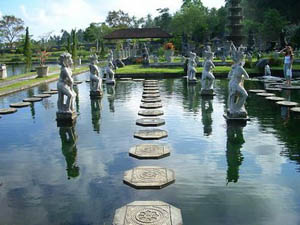 This water palace stand on a 1.2 hectare area with three different level/part outstretched from east to west. These levels symbolize the concept of “Tri Loka” or “three worlds” of Hindu. The first part is an attracting pond on the right side when first entering this water palace, which is decorated by some stones and sculptures. Some of these stones are arranged on the pond and used for step stone to walk over the pond. This part is called “Swah”, the place for Gods. Many visitors would like to walk over these stones to feel the sensation of walking on the water. Here, you can also see some statues of Gods and Goddess over the pool, some fish swimming elegantly under water, and a swimming pool. In the middle of the area, there is an elegant eleven-tiered Nawa Sanga fountain. This fountain and two ponds in this area forms the “Bwah,” symbolizing the world of human being. Meanwhile, the “Bhur” level which symbolizes the world of evils is located on the left side from the entrance. It is occupied by the big pond with a long Demon Island in the middle.
This water palace stand on a 1.2 hectare area with three different level/part outstretched from east to west. These levels symbolize the concept of “Tri Loka” or “three worlds” of Hindu. The first part is an attracting pond on the right side when first entering this water palace, which is decorated by some stones and sculptures. Some of these stones are arranged on the pond and used for step stone to walk over the pond. This part is called “Swah”, the place for Gods. Many visitors would like to walk over these stones to feel the sensation of walking on the water. Here, you can also see some statues of Gods and Goddess over the pool, some fish swimming elegantly under water, and a swimming pool. In the middle of the area, there is an elegant eleven-tiered Nawa Sanga fountain. This fountain and two ponds in this area forms the “Bwah,” symbolizing the world of human being. Meanwhile, the “Bhur” level which symbolizes the world of evils is located on the left side from the entrance. It is occupied by the big pond with a long Demon Island in the middle.
Tirta Gangga is always crowded by many visitors especially in the weekend. This place is a perfect place for family or self relaxing excursion because of its surrounding panorama and peaceful atmosphere. Besides visiting this beautiful Tirta Gangga water palace, you can also go to some of these tourism objects located in Karangasem Regency.
Taman Ujung Palace
This palace was built in 1912 by the late King of Karangasem, I Gusti Bagus Jelantik, which reigned in Karangasem between 1909 and 1945. This palace is very grandiose with combination of Balinese, Dutch, and Chinese architecture.
Puri Agung Karangasem
Puri Agung Karangasem or Karangasem Palace is the residential area of Karangasem King which also combine three different architectures. Balinese architecture could be seen on the carvings, statues, and reliefs on the buildings. Meanwhile European (Dutch) architecture is reflected on the style of the main building with its large veranda, and Chinese architecture is implied on the style of the window, the door, and other decorations.
Candidasa Beach
A beautiful beach with a dazzling panorama of Indian Ocean. This beach has sparkling white sand along its coastline. From this beach, Lombok Island and Nusa Penida are also observable.
Teganan Pegringsingan
Tenganan Pegringsingan is a surviving Balinese ancient village with its unique buildings, culture, and tradition. Many temple festivals could be seen in this village like “Mekare-kare” or “Perang Pandan”. This village is also famous for its kamen or Balinese sarong called Kamen Gringsing which is very artistic and valuable.


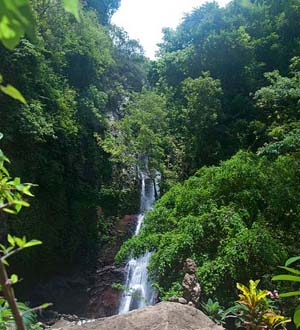 Bali is the main tourism destination in Indonesia. Well, most of people are aware of that. However there are so many hidden tourism spot you can find in Bali. And most of them have their own unique and hidden beauty. One of the good examples is the Waterfall of Les village. If you are eager to spend holiday exploring the beauty of northern part of Bali, Les Waterfall is a great choice to visit. It is located in Les village on the eastern part of Buleleng Regency, 38 kilometer to the east from Singaraja, and about 50 kilometers from Lovina.
Bali is the main tourism destination in Indonesia. Well, most of people are aware of that. However there are so many hidden tourism spot you can find in Bali. And most of them have their own unique and hidden beauty. One of the good examples is the Waterfall of Les village. If you are eager to spend holiday exploring the beauty of northern part of Bali, Les Waterfall is a great choice to visit. It is located in Les village on the eastern part of Buleleng Regency, 38 kilometer to the east from Singaraja, and about 50 kilometers from Lovina. 
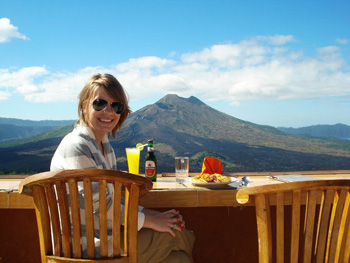


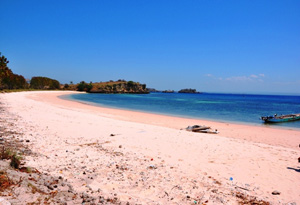 Although some beaches in Lombok like Senggigi and Gili Trawangan area have been famous for the tourists, actually they still do not know that there is a beautiful virgin beach with its pink sand called Tangsi beach. This beach is located in East Lombok Regency, Jerowaru sub district. Tangsi Beach is on the rise, because in the past not many people know about this hidden gem. Even, the local people does not really aware that this beach could become a good tourism object. Recently, a mass media exposed its potential so that people flock to visit this beach.
Although some beaches in Lombok like Senggigi and Gili Trawangan area have been famous for the tourists, actually they still do not know that there is a beautiful virgin beach with its pink sand called Tangsi beach. This beach is located in East Lombok Regency, Jerowaru sub district. Tangsi Beach is on the rise, because in the past not many people know about this hidden gem. Even, the local people does not really aware that this beach could become a good tourism object. Recently, a mass media exposed its potential so that people flock to visit this beach. 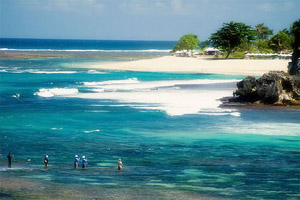
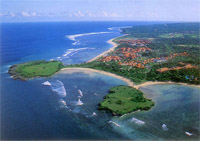 Besides all of those uniqueness, Geger Beach still has a uniqueness to offer, that is camel safari along the coast. You do not need to go to Egypt to feel the sensation of riding camel, because here the camels are ready to take you walking around. The only difference is these camels will not take you crossing a burning sandy desert, but a beautiful sandy beach. In exploring this beach, some routes are already provided by the administrators of the beach, so you do not need to worry that you may get lost. This camel safari usually take 1 hour to enjoy, which will be one of the most unique experiences in your life. Actually, now Geger Beach is also completed with some facilities like masseur, venders, souvenirs shops, and some restaurants. Tourists could try various selection of seafood in these restaurants.
Besides all of those uniqueness, Geger Beach still has a uniqueness to offer, that is camel safari along the coast. You do not need to go to Egypt to feel the sensation of riding camel, because here the camels are ready to take you walking around. The only difference is these camels will not take you crossing a burning sandy desert, but a beautiful sandy beach. In exploring this beach, some routes are already provided by the administrators of the beach, so you do not need to worry that you may get lost. This camel safari usually take 1 hour to enjoy, which will be one of the most unique experiences in your life. Actually, now Geger Beach is also completed with some facilities like masseur, venders, souvenirs shops, and some restaurants. Tourists could try various selection of seafood in these restaurants.
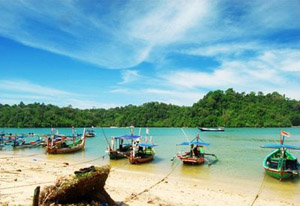
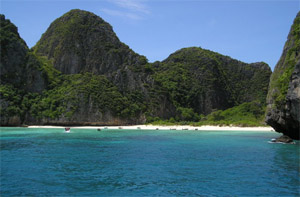 Sempu Island is a tropical small island located in the southern part of Java Island. This island is registered in the area of Malang Regency, East Java. Now, Sempu Island is declared as a wildlife sanctuary/conservation area by the government of Indonesia. Surprisingly, there is no brackish spring found in this area, even though the island is small and surrounded by ocean. Sempu Island has an area of approximately 877 hectare which is adjacent with Sempu Strait (Sendang Biru) and surrounded by Indian Ocean in the south, east, and west side. Sempu Island could be reached from Malang through Sendang Biru Beach. You could contact the local fishermen to rent their raft or boat and to get a permission/license to cross the strait into this beautiful island.
Sempu Island is a tropical small island located in the southern part of Java Island. This island is registered in the area of Malang Regency, East Java. Now, Sempu Island is declared as a wildlife sanctuary/conservation area by the government of Indonesia. Surprisingly, there is no brackish spring found in this area, even though the island is small and surrounded by ocean. Sempu Island has an area of approximately 877 hectare which is adjacent with Sempu Strait (Sendang Biru) and surrounded by Indian Ocean in the south, east, and west side. Sempu Island could be reached from Malang through Sendang Biru Beach. You could contact the local fishermen to rent their raft or boat and to get a permission/license to cross the strait into this beautiful island.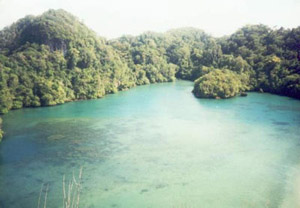
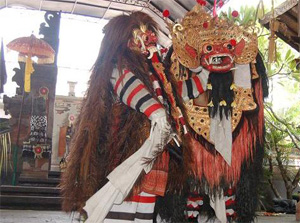
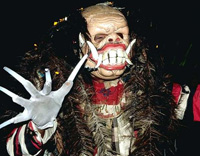 Meanwhile, the mythological elements come from the source of the story which is taken from pre-Hindu tradition when Barong was believed as the guardian of virtue. Mythological could also be seen from the costume of Barong which is made from woods taken in mystical places like cemetery. Besides that, Barong dance performance is usually interspersed with Keris Dance. Keris dance also contains mystical aspects in it, because in this dance a group of people try to stab themselves with keris (Balinese dagger), but surprisingly those sharp daggers could not penetrate their body.
Meanwhile, the mythological elements come from the source of the story which is taken from pre-Hindu tradition when Barong was believed as the guardian of virtue. Mythological could also be seen from the costume of Barong which is made from woods taken in mystical places like cemetery. Besides that, Barong dance performance is usually interspersed with Keris Dance. Keris dance also contains mystical aspects in it, because in this dance a group of people try to stab themselves with keris (Balinese dagger), but surprisingly those sharp daggers could not penetrate their body.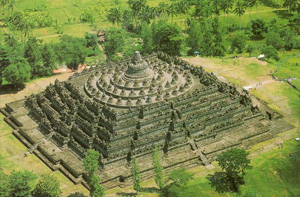
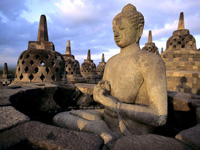 By visiting Borobudur and Buddhist texts he got from Serlingpa (one of the king of Sriwijaya Kingdom), Atisha could develop Buddhism. He was chosen to be the leader of Vikramasila Monastery and taught the Tibetan to practice Dharma or the truth. Six scripts made by him also were summarized into core of a teaching called “The Lamp for the Path to Enlightenment” or usually known as Bodhipathapradipa.
By visiting Borobudur and Buddhist texts he got from Serlingpa (one of the king of Sriwijaya Kingdom), Atisha could develop Buddhism. He was chosen to be the leader of Vikramasila Monastery and taught the Tibetan to practice Dharma or the truth. Six scripts made by him also were summarized into core of a teaching called “The Lamp for the Path to Enlightenment” or usually known as Bodhipathapradipa.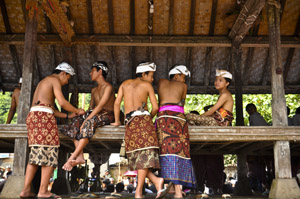
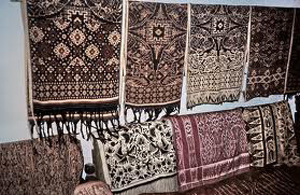 Kamen Gringsing is a kind of kamen which is highly rated in Bali because of its beauty, materials, and complicated making process. In this village you can find kamen gringsing easily but also with a high price. That price is actually quite reasonable since the coloring process of this traditional cloth could takes years until finish. There are three dominant colors in every kamen; red, yellow or white, and black. The color of red is made from the root bark of a noni tree; yellow is from hazelnut and black is from a kind of grass. Gringsing is derived from word “gring” means “ill” and “sing” which means “not,” so it could be said that the meaning of gringsing is “not ill.” This meaning is also related to balance of universe elements symbolized in the kamen. Yellow is for symbolizing air, meanwhile red is for fire, and black is for water. If one of these elements in human body is disturbed, illness will occur. It means that human should also keep the elements of nature to balance the “health” of the universe.
Kamen Gringsing is a kind of kamen which is highly rated in Bali because of its beauty, materials, and complicated making process. In this village you can find kamen gringsing easily but also with a high price. That price is actually quite reasonable since the coloring process of this traditional cloth could takes years until finish. There are three dominant colors in every kamen; red, yellow or white, and black. The color of red is made from the root bark of a noni tree; yellow is from hazelnut and black is from a kind of grass. Gringsing is derived from word “gring” means “ill” and “sing” which means “not,” so it could be said that the meaning of gringsing is “not ill.” This meaning is also related to balance of universe elements symbolized in the kamen. Yellow is for symbolizing air, meanwhile red is for fire, and black is for water. If one of these elements in human body is disturbed, illness will occur. It means that human should also keep the elements of nature to balance the “health” of the universe.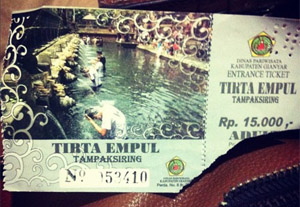 Back then, when Tenganan Pegringsingan began to attract a lot of tourists, Karangasem Government suddenly imposed tourism levies from this village. Extortions from various parties at that time were firmly rejected because it was imposed without villagers’ agreement as the owner of the village.
Back then, when Tenganan Pegringsingan began to attract a lot of tourists, Karangasem Government suddenly imposed tourism levies from this village. Extortions from various parties at that time were firmly rejected because it was imposed without villagers’ agreement as the owner of the village. 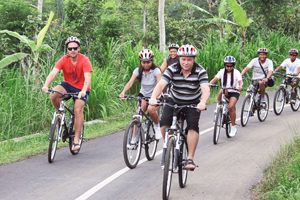
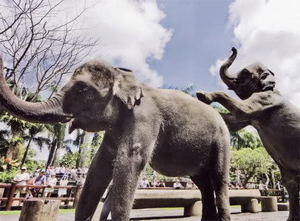 However, with the natural beauty of Taro village, now near the forest of the oxen, a new kind of tourists attraction and the only one in Bali is developed, Elephant Safari. Taro Elephant Safari Park was build in 1989, when a couple Nigel Mason dan Yanie came up with an idea of making a safari park in this village. Together, they developed this elephant safari park up until now, when it is famous and crowded by both local and foreign tourists.
However, with the natural beauty of Taro village, now near the forest of the oxen, a new kind of tourists attraction and the only one in Bali is developed, Elephant Safari. Taro Elephant Safari Park was build in 1989, when a couple Nigel Mason dan Yanie came up with an idea of making a safari park in this village. Together, they developed this elephant safari park up until now, when it is famous and crowded by both local and foreign tourists.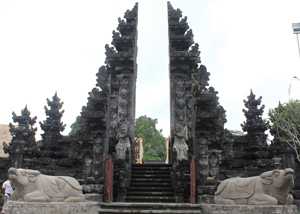 Besides that, you could also visit Gunung Raung Temple which is located near the elephant safari park. This temple is full of historical value, related to the history of Hinduism development in Bali and also the history of this village’s name origin. Moreover, the construction of this temple is highly related to the holy journey of Rsi Markandya, a holy priest of Hindu, from East Java to Bali.
Besides that, you could also visit Gunung Raung Temple which is located near the elephant safari park. This temple is full of historical value, related to the history of Hinduism development in Bali and also the history of this village’s name origin. Moreover, the construction of this temple is highly related to the holy journey of Rsi Markandya, a holy priest of Hindu, from East Java to Bali.